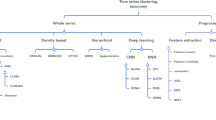Abstract
This paper proposes a method of context-aware edge similarity segmentation algorithm of time series. The algorithm overcomes the machinery of traditional pattern discovery and traditional pattern matching and breaks the limitation of the fixed mode of boundary movement. The algorithm also has stronger adaptive capacity in the humanities sequence activities based on the network. Considering the edge connected by the adjacent points of time series as a fragment, and combining the similarity between the edges calculated by context relation to extract edge density, we can obtain data groups with similar characteristics with the clustering algorithm. This method can not only find the implicit relationships between edges, but also can increase time series segmentation robustness. Experimental results show that our algorithm can reduce the failure rate of segments caused by only considering the pattern matching, and has better anti-interference performance in noisy environments.








Similar content being viewed by others
References
Lei, W., Xie, S., Su, D., Wang, G.: An autonomous detection and robust estimation method of spectrum anomaly based on time series analysis. Chin. J. Electron. 42(6), 1055–1060 (2014)
Meng, J., Xiao-jiang, C., Ding-yi, F.: Temperature-Adaptive time synchronization for wireless sensor networks. J. Softw. 43(2), 412–416 (2015)
Ma, J., Liu, J., Wang, B.: A temperature field measurement method of billet based on multi-information fusion and the analysis of influencing factors. Chin. J. Electron. 43(8), 1616–1620 (2015)
Lake, B.M., Salakhutdinov, R., Tenenbaum, J.B.: Human-level concept learning through probabilistic program induction. Science 12(14), 1332–1339 (2015)
Yan, H., Yuan, N., He, W.: Detection of significant external trend in long-term air temperature records. Acta Phys. Sin. 64(2), 1–11 (2015)
Keogh, E., Chu, S., Hart, D., Pazzani, M.: Segmenting time series: a survey and novel approach. Data Min. Time Ser. Databases 57, 1–21 (2003)
Liu, X., Lin, Z., Wang, H.: Novel online methods for time series segmentation. IEEE Trans. Knowl. Data Eng 20(12), 1616–1626 (2008)
Lendasse, A., Lee, J., de Bodt, E., Wertz, V., Verleysen, M.: Dimension reductionof technical indicators for the prediction of financial time series-application to the BEL20 market index. Eur. J. Econ. Soc. Syst. 15(2), 31–48 (2001)
Omranian, N., Mueller-Roeber, B., Nikoloski, Z.: Segmentation of biological multivariate time-series data. Sci. Rep. 5, 8937 (2015)
Zou, C., Jiang, W., Tsung, F.: A lasso-based diagnostic framework for multivariate statistical process control. Technometrics 53(3), 297–309 (2011)
McCarty, J.A., Hastak, M.: Segmentation approaches in data-mining: acomparison of Rfm, chaid, and logistic regression. J. Bus. Res. 60(6), 656–662 (2007)
Duchene, F., Garbay, C., Rialle, V.: Learning recurrent behaviors from heterogeneous multivariate time-series. Artif. Intell. Med. 39(1), 25–47 (2007)
Tadepalli, S., Ramakrishnan, N., Mishra, B., Watson, L.T.. Helm, R.F.: Deriving Kripke structures from time series segmentation results. In: The 9th International Workshop on Discrete Event Systems, pp. 406–411 (2008)
Picard, F., Lebarbier, E., Budinska, E., Robin, S.: Joint segmentation of multivariate gaussian processes using mixed linear models. Comput. Stat. Data Anal. 55(2), 1160–1170 (2011)
Angelosante, D., Giannakis, G.B.:. Sparse graphical modeling of piecewise-stationary time series. In: IEEE International Conference on Acoustics, Speech and Signal Processing, pp. 1960–1963 (2011)
Chung, F.L., Fu, T.C., Ng, V., Luk, R.W.P.: An evolutionary approach to pattern-based time series segmentation. IEEE Trans. Evol. Comput. 8(5), 471–489 (2004)
Tseng, V.S., Chen, C.-H., Huang, P.-C., Hong, T.-P.: Cluster-based genetic segmentation of time series with DWT. Pattern Recogn. Lett. 30(13), 1190–1197 (2009)
Aue, A., Cheung, R.C., Lee, T.C., Zhong, M.: Segmented model selection inquantile regression using the minimum description length principle. J. Am. Stat. Assoc. 109(507), 1241–1256 (2014)
Toyoda, M., Sakurai, Y., Ishikawa, Y.: Pattern discovery in data streams under the time warping distance. VLDB 22(3), 295–318 (2013)
Xing-dong, W., Zhang-qiang, X., Xin-wu, L., Lei, L.: Antarctic ice-sheet freeze-thaw detection based on improved wavelet transform. Chin. J. Electron. 41(2), 402–406 (2013)
Bicego, M., Murino, V., Figueiredo, M.A.T.: Similarity-based clustering of sequences using hidden Markov models. In: Proceedings of the 3rd International Conference on Machine Learning and Data Mining in Pattern Recognition, pp. 86–95. Springer, Berlin (2003)
Ramakrishnan, N., Tadepalli, S., Watson, L.T., Helm, R.F., Antoniotti, M.: Reverse engineering dynamic temporal models of biological processes and their relationships. Proc. Natl. Acad. Sci. USA 107(28), 12511–12516 (2010)
Yang, K., Shahabi, C.: An efficient k-nearest neighbor search for multivariate time series. Inf. Comput. 205(1), 65–98 (2007)
Ramoni, M., Sebastiani, P., Cohen, P.: Bayesian clustering by dynamics. Mach. Learn. 47(1), 91–121 (2002)
Graves, D., Pedrycz, W.: Multivariate segmentation of time series with differential evolution. In: Proceedings of the Joint 2009 International Fuzzy Systems Association World Congress and 2009 European Society of Fuzzy Logic and Technology Conference, Lisbon, Portugal, pp. 1108–1113 (2009)
Xu, B., Song, A., Fei, S.: Feature extraction and classification of EEG in online brain-computer interface. Chin. J. Electron. 39(5), 1025–1030 (2011)
Yi-ming, Y., Rong, P., Jia-lin, P.: A Comparative study on time series classification. Chin. J. Comput. 30(8), 1259–1266 (2007)
Alex, R., Alessandro, L.: Clustering by fast search and find of density peaks. Science 344(96191), 1492–1496 (2014)
Ahn, Y.-Y.: Link communities reveal multiscale complexity in networks. Nature 466(7307), 761–764 (2010)
Omranian, N., Klie, S., Mueller-roeber, B., Nikoloski, Z.: Network-based segmentation of biological multivariate time series. PLoS One 8(5), 1–10 (2013)
Zhu, Y., Dai, D., Xiong, Y.: A survey of the researchon similarity query technique of sequence data. J. Comput. Res. Dev. 42(2), 264–276 (2010)
Qiu-yan, Y., Shi-xiong, X.: An Piecewise linear fitting algorithm for infinite time series. Chin. J. Electron. 38(2), 443–448 (2010)
Wen-Jie, D., Guo-Ling, F., Zhi-Qiang, G., Jian-Ping, L.: Abrupt climate change detection based on heuristic segmentation algorithm. Acta Phys. Sin. 54(11), 5494–5499 (2005)
Kim, S.-H., Jeong, Y.-S.: Mobile image sensors for object detection using color segmentation. Clust. Comput. 16(4), 757–763 (2013)
Author information
Authors and Affiliations
Corresponding author
Rights and permissions
About this article
Cite this article
Wang, L., Xu, L., Yu, J. et al. Context-aware edge similarity segmentation algorithm of time series. Cluster Comput 19, 1421–1436 (2016). https://doi.org/10.1007/s10586-016-0604-7
Received:
Revised:
Accepted:
Published:
Issue Date:
DOI: https://doi.org/10.1007/s10586-016-0604-7




